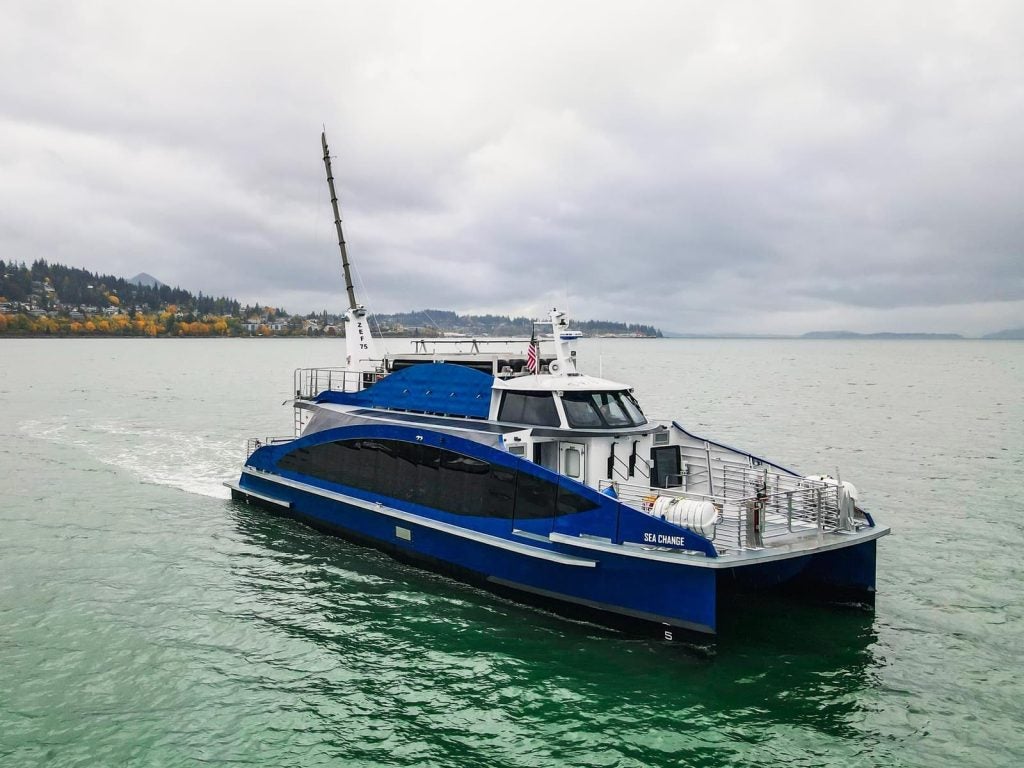
The decarbonisation of the maritime industry has become a focal point for many of its biggest companies, with significant investments made to reach net zero targets through more efficient technologies and sustainable fuels.
However, while some of those fuels – such as liquefied natural gas (LNG) and methanol – are already being used on ships as lower-emission alternatives to traditional marine fuels, both have their disadvantages and impact the environment in different ways.
Electric engines have also gained popularity in recent decades, but have largely been relegated to smaller vessels due to the difficulty found in getting them to generate the kind of power needed for commercial cargo ships.
It’s no surprise then, that many companies continue to develop alternative power sources for the industry, looking at fuels such as hydrogen, ammonia, and even nuclear power.
One such company is Amogy, which is hoping its ammonia-based technology will play a part in the future of the maritime sector. Director of maritime business development, Anastasija Kuprijanova, explains more about the development of ammonia fuel and the role Amogy could play in a more sustainable shipping industry.

Noah Bovenizer: What makes Amogy stand out in the alternative fuel space?
Anastasija Kuprijanova: What we do is develop ammonia power solutions, so we have a proprietary ammonia cracking solution with direct fuel cell integration that allows for distributed power generation and a zero-carbon energy source predominantly targeting applications in the maritime sector.
How well do you really know your competitors?
Access the most comprehensive Company Profiles on the market, powered by GlobalData. Save hours of research. Gain competitive edge.

Thank you!
Your download email will arrive shortly
Not ready to buy yet? Download a free sample
We are confident about the unique quality of our Company Profiles. However, we want you to make the most beneficial decision for your business, so we offer a free sample that you can download by submitting the below form
By GlobalDataSo you can really think of the core of our intellectual property being in the chemical processing before the molecule enters into the fuel cell.
One of the things that makes us most competitive on the market, and somewhat revolutionary in the space, is a very highly efficient catalyst that we develop in-house.
That catalyst is the key to our reactor and being able to ‘crack’ the ammonia at lower temperatures than conventionally available crackers currently on the market, and therefore also allowing for our solution to be much smaller than those crackers that are on the market.
NB: Could you outline the company’s main product and how it works?
AK: The Amogy Power Pack is a complete ammonia power solution comprised of two modules, with about 40% of the overall footprint of the power pack consisting of the fuel cell itself.
The remaining 60% is Amogy’s ‘secret sauce’ in a lot of our science, so cracking that ammonia into the referment stream, cleaning that referment stream so there are no trace amounts of ammonia leftover – since ammonia would be damaging to a fuel cell – and then making proprietary modifications to those low-temperature pad fuel cells to make them compatible with that referment stream, and then out comes a clean source of energy.
This is a technology that we have now proven and demonstrated several times, each time scaling the technology on the technology readiness scale. Our first demonstration was at the very beginning of our organisation’s inception, and that was at the 5kW scale with a drone that we flew here in Connecticut. We scaled the technology 20-fold to a tractor and then in January of 2023, a class eight truck at the 200kW scale.
This is a technology that we have now proven and demonstrated several times.
That was our last demonstration project, up until we embarked on what is now our final demonstration project, directly in our core target market with the maritime industry. That is the conversion of a tugboat at the 1mW scale with our technology which is a retrofit that is currently taking place at Phoenix Shipyard in Kingston, New York.
It will be our last and final demonstration project, and it will showcase our technology in that direct maritime application and allow us to put the first ammonia-powered vessel out on the market, out in the water.
NB: You have had a successful career in the maritime industry, what drew you to Amogy in particular?
AK: Over the last decade or so I have developed a huge passion for alternative propulsion and renewable technologies in the maritime sector.
Unfortunately, I think that unless there are folks like us engaged in the maritime sector, the normal public doesn’t realise how critical maritime is to all industries and our global supply chain. Beyond just cargo transportation, our waterways are also critical for transportation in general.
I first started my career focused on the transportation portion, so a lot of work in the public-private sector, and a lot of P3 agreements for public ferry services. Through that, I had the opportunity to work on a number of different renewable alternative propulsion projects, including electric vessels and hybrid electric.
I had the opportunity to work alongside the Hornblower team that was serving as the systems integrator and owner’s representative for the Sea Change, which is the first domestically launched hydrogen-powered vessel [in the US], and through that experience, I saw first-hand that batteries can only take you so far. An all-electric vessel is normally a purpose-built vessel, it’s operating on one given route and that’s about the extent of its range.

Unfortunately, hydrogen and fuel cells are similar to that, so first-hand I was able to see the lack of a supply chain for hydrogen, the cost of hydrogen, and the difficulty in storing hydrogen. All of those factors together do not make it a very palatable solution for an industry that is based on on-time performance and reliability.
So when I first learned of ammonia as a potential hydrogen carrier, that was something that was really interesting and intriguing to me. Especially with ammonia being a molecule that we as a society already know, we handle it as a cargo, it’s readily available in more than 200 ports worldwide, and it’s transported over our waterways as a cargo.
I wanted to look at being able to unlock its potential, utilise some of that already established supply chain, and also really ride the fantails of a lot of the development that’s going into green ammonia production.
NB: Do you see Ammonia as the only way forward for the maritime industry? what are some of the strengths and weaknesses of other fuels?
AK: So right now, the maritime industry is navigating a fundamental energy shift, which is quite exciting but with that also comes a number of different solutions. My personal opinion is that there is not going to be a one-shoe-fits-all future fuel to support the maritime industry.
It’s going to be a combination of future fuels and alternative propulsion solutions, each of which is best suited and best targeted for various vessel types, depending on their range, operational profile, vessel size, and the geography in which it’s operating – and ensuring that it has the supply chain there.
All of these fuels have their own benefits, and in other ways have some challenges that they present during adoption in the maritime space. We know for a fact that batteries are going to continue to play a prominent role, as batteries are a critical component of a lot of adoption of these future fuels, and in fact, batteries are something that Amogy’s system requires as well.
There is not going to be a one-shoe-fits-all future fuel to support the maritime industry.
Methanol does present an interesting solution as well, it is a fuel that can be integrated into a standard two or four-stroke engine, which of course makes the adoption process somewhat faster than some of these additional new systems. Although methanol is also energy-dense, it’s not as energy-dense as diesel or ammonia and that’s why a lot of these challenges present themselves.
But methanol is a carbon-based fuel, so you do have CO2 emissions, you will still need a scrubber, and you will still need other aspects of decarbonisation solutions onboard your vessel to meet some of these very stringent regulations and goals that folks are setting forward.
Also, LNG will continue to play a role, and other biofuels as well, there are more renewable energies that are quickly making their way into these conversations as well, including nuclear and wind power.
But to take a step back and summarise all of these thought processes, if you look at the publications of the three major classification societies over the last year or so and their projections on future fuels, they define it in twofold: The methanol track and the ammonia track.
NB: What is the timeline for Amogy’s journey towards commercial sales?
AK: The tugboat is our last and final demonstration project and we look forward to having her set sail, with that retrofit actively underway right now. We will be able to utilise that project for a lot of data collection and hopefully also pave the way for regulatory [approval], which is absolutely critical when you’re talking about new technologies and new future fuels.
Following that demonstration project, so at the tail end of 2024 and early 2025, Amogy’s focus will be on the deployment of pilot projects. That means deploying our technologies in the maritime sector for pilot projects with key customers and stakeholders.
Then following that, in mid-2025, it’s full commercialisation and availability of our technology. Presales are already actively underway, so there is an option for vessel owners, operators, and various other stakeholders to be able to get a spot in line and secure an Amogy Power Pack, as well as potentially a pilot project opportunity if it is a slightly earlier adoption.



